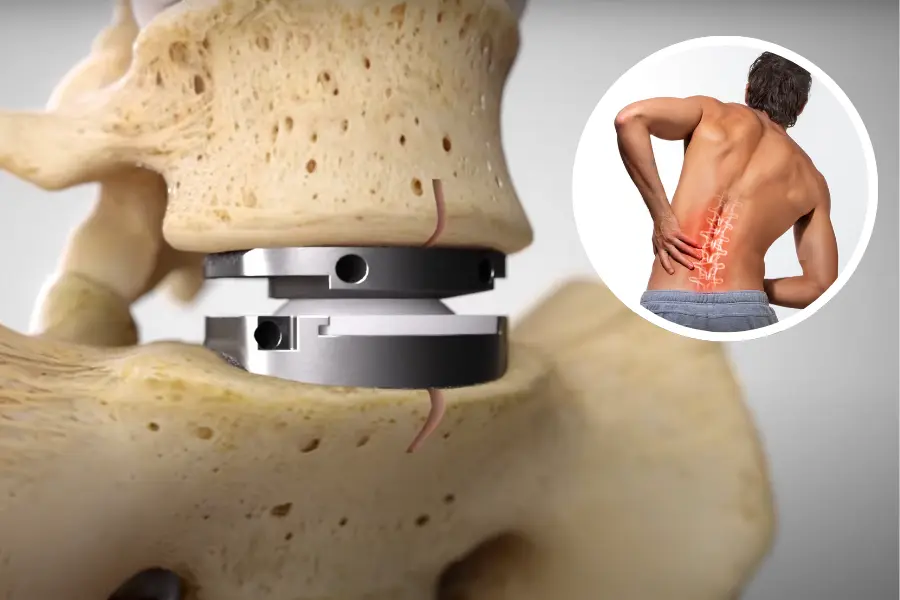
Which Lumbar Artificial Disc Is Best for My Lower Back Condition?
It can be very overwhelming to learn that you might need an artificial disc replacement, and even more overwhelming to learn that different kinds of discs could possibly be used. A question we commonly get as a practice is what disc is the best for one’s lower back or lumbar condition. In a world full of information and differing opinions, it can be challenging to sift through this data and determine what disc and doctor you should be trusting. Being at the forefront of total disc replacement surgery (TDR) since 2005, we want to shed light on this important topic and ensure our patients are properly educated on both their conditions and their treatment options.
Which lumbar spine conditions are a candidate for disc replacement surgery?
Degenerative Disc Disease
A common spine condition that might benefit from a lumbar disc replacement is degenerative disc disease (DDD). This degenerative process takes place throughout the spine, but most often occurs in the discs of the lower back or the lumbar region. Pain generally occurs near the location of the affected disc and becomes worse with movement and activity.
Disc Herniations
Suffering from a lumbar disc herniation is another common reason that someone might need a disc replacement surgery. A disc herniation is a displacement of disc material beyond the normal confines of the disc space, which often results in nerve pinching and shooting pain. As with any spinal condition, it is important to discuss treatment options with your doctor and explore nonsurgical approaches to promote healing.
Failed Prior Surgery
Some patients are recommended for disc replacement surgery after a previous failed surgery that did not resolve their spinal issues. Unfortunately, some patients seek care because they never felt fully improved after that procedure or they even felt their pain worsen. It is important to consult a spine specialist to discern if your symptoms are normal and expected post-surgery, or if there is need for further treatment to resolve your symptoms.
The treatments for these spinal conditions depend on the patient and the affected area of the spine. If physical therapy and regenerative medicine options are not providing results, artificial disc replacement surgery, also known as arthroplasty, may be the best treatment to restore the quality of life for the patient. This decision is made in collaboration between the patient and the spine specialist, who looks holistically at the journey that the patient has made.
Which lumbar artificial disc is right for me?
For lower back conditions in which surgery is the recommended solution, there are two lumbar discs that are FDA-approved and always used by our team for disc replacement surgeries. These lumbar disc types are called activL® and prodisc® L. They each have specific benefits that are considered when a specialist is deciding the best treatment options for a patient undergoing disc replacement surgery.
activL®
The activL® disc is an artificial disc with intelligent motion technology. This is a third-generation motion preservation device that is designed to closely mimic the natural biomechanics of the healthy human spine and significantly reduce the impact on corresponding levels of the spine. Similar to updated versions of the iPhone, they are always improving these disc types and releasing new versions to ensure that this disc is providing the best results.
The activL® disc blends mechanical stability and natural motion with a high-weight core that helps promote movement. This device has the capability to individually conform to a patient’s anatomical needs through a wide range of endplate configurations and construct heights. This device has shown significant improvements in pain, functionality, and opioid use after seven years.
prodisc® L
The prodisc® L is a well-studied total disc replacement technology and has been used in surgeries for over thirty years. This second-generation disc is also used in instances that require a two-level lumbar disc replacement where the spinal condition is affecting more than one layer of the spine. Surgical procedures with this technology are intended to do the following:
- Remove the diseased disc
- Restore normal disc height
- Reduce lower back pain
- Potentially provide motion in the affected area
The prodisc® L implant has many features and advantages that make it a good recommendation for artificial disc replacement. This device has a ball and socket design with a fixed center of rotation which allows a natural range of motion while giving the spine stability and lowering the need for subsequent surgeries at the nearby levels. Its structure and diverse sizes also facilitate an accurate and unique match with the patient’s anatomy.
How do doctors decide which disc to use?
When making the recommendation to move forward with surgery, a spine specialist should take into account various factors, including the patient’s anatomy, medical history, and recovery goals. In the case of two- or three-level disc replacement surgery, our surgeons may use a combination of different discs in order to tailor the surgery to each patient’s specific needs. Every patient is different and having an open line of communication will help the doctor have a full picture of what each patient needs. Customized care and building mutual trust is vitally important for the success of any surgery.
With all this information at the disposal of our spine specialists, they make careful decisions on what device and technology to use for each patient. Our surgeons are equipped to guide you through the selection process and provide you with recommendations based on your specific anatomy and degree of your condition. In addition, our surgeons are at the forefront of new technology and techniques being used in disc replacement surgery to ensure our patients are receiving the best, unique care to get them back to the full and active lives they deserve.
Topics covered
About the Author
Featured Resources
Insights to Achieve a Pain-Free Life



